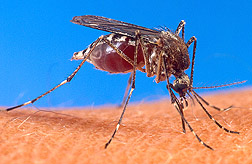This page has been archived and is being provided for reference purposes only. The page is no longer being updated, and therefore, links on the page may be invalid.
Computer Model for Finding Mosquito Repellent Compounds
By Sharon DurhamMay 28, 2008
Summer reminds us that one of the most useful tools for preventing mosquito bites is insect repellent. Agricultural Research Service (ARS) scientists and colleagues at the University of Florida (UF) have shown that a computer modeling program that looks at compounds' chemical structure can predict which compounds are likely to stop mosquito bites. Their findings are reported in the Proceedings of the National Academy of Sciences.
ARS is the chief scientific research agency of the U.S. Department of Agriculture (USDA).
For more than 50 years, DEET has been the "gold standard" of mosquito repellents. DEET was discovered during a USDA screening program that tested 40,000 chemicals in an expensive process that took a decade.
The ARS research team included chemist Ulrich Bernier; Gary Clark, research leader of the Mosquito and Fly Unit at ARS' Center for Medical, Agricultural and Veterinary Entomology (CMAVE) in Gainesville, Fla.; and CMAVE Director Kenneth Linthicum. The UF researchers were Alan R. Katritzky, Zuoquan Wang, Svetoslav Slavov, Maia Tsikolia, Dimitar Dobchev, Novruz G. Akhmedov and C. Dennis Hall of the Center for Heterocyclic Compounds, also in Gainesville.
In the research, a modeling system that can use chemical structures and insect receptors was used to predict repellents’ effectiveness against mosquitoes. The researchers used a particularly efficient approach, called quantitative structure-activity relationship, or QSAR. They chose a modeling system called an artificial neural network (ANN), because it can test theoretical compounds generated by the computer against a complicated phenomenon like duration of repellency.
A dataset of 200 known compounds tested for repellency between 1950 and 1980 from the USDA screening program was used as the base data for the modeling. This phase of the work “trained” the neural network to recognize the most effective kinds of chemicals. Then, 23 novel compounds were tested under ANN, some of which were predicted by lab tests to repel mosquito bites three times longer than the equivalent concentration of DEET.
This approach may streamline the process of testing new active ingredients, lead to repellents that are longer lasting, and bring them to market faster.

